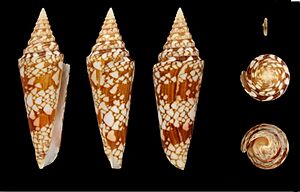Conus milneedwardsi facts for kids
Quick facts for kids Conus milneedwardsi |
|
|---|---|
 |
|
| Shell and protoconch of Conus milneedwardsii (specimen at the Smithsonian Institution) | |
| Conservation status | |
| Scientific classification | |
| Synonyms | |
|
Conus milneedwardsi is a special kind of sea snail. It's also known as the "Glory of India" because of its beautiful shell. This snail is a mollusk, which is a group of animals with soft bodies, often protected by a shell. It belongs to the Conidae family, also called cone snails.
Like all cone snails, Conus milneedwardsi is a predatory animal. This means it hunts other small sea creatures for food. It's also venomous, so it can sting. Because of this, it's very important to be careful and never touch a live one.
Some scientists divide Conus milneedwardsi into different types, called subspecies. One of these is Conus milneedwardsi milneedwardsi, which is also known as the Glory of India cone.
What Does It Look Like?
The shell of an adult Conus milneedwardsi can be anywhere from about 4.6 centimeters (about 1.8 inches) to 19.3 centimeters (about 7.6 inches) long. That's quite a range!
This snail has a shell that is fairly thin and long. Its surface feels smooth. The top part of the shell, called the spire, is pointed. The "shoulder" of the shell, where the spire meets the main body, has a sharp angle.
The shell is usually white. It has two spiral bands of a chocolate-brown color on its main part, called the body whorl. This body whorl also has a cool pattern of reddish-brown lines that crisscross. These lines create small white shapes, like triangles or squares, all over the shell.
Where Does It Live?
This marine snail lives in the ocean. You can find it off the coast of Madagascar. It also lives along the African coast, from KwaZulu-Natal, South Africa, all the way up to the Red Sea. You can also find it in the China Sea and in the Indian Ocean near Bombay (now Mumbai).
Different subspecies live in slightly different places. For example, the subspecies C. m. clytospira lives from Pakistan to India and Sri Lanka. Another subspecies, C. m. lemuriensis, is found in the Indian Ocean near islands like Réunion and Mauritius.


